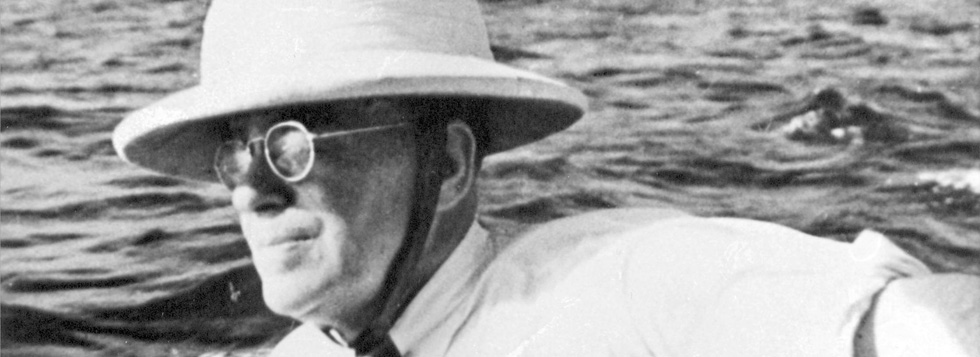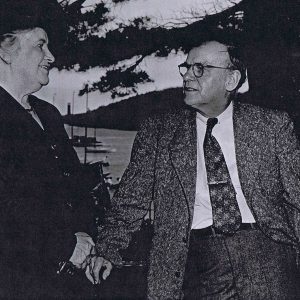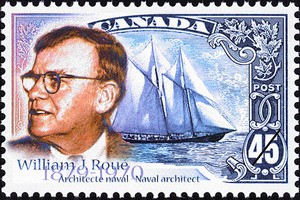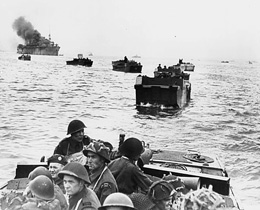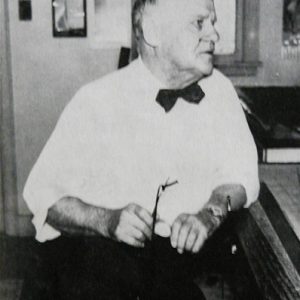William J. Roué (1879-1970) | Biography
Recognized as Canada’s first naval architect and still appreciated as one of the best ever, William James Roue’s masterpiece, the legendary schooner Bluenose, has been globally recognized since 1921 as a symbol of excellence – hailed as a perfect blend of art and engineering.
Roué was born in Halifax, Nova Scotia in 1879. As a young school boy, he was more interested in drawing yachts than paying attention to his teachers. As a teenager, when he was still too young to become a member of the Royal Nova Scotia Yacht Squadron, he spent hours on the water studying every nuance, every secret the boats and the water could teach him until he could handle a tiller “like a fine violinist handled his bow.”
When he was 17 he got into a dispute with his school teacher over the pronunciation of a nautical term. He never went back, deciding to turn his focus to learning what he needed to know in order to pursue his dream of becoming a naval architect.
And so he enrolled in night classes in Halifax’s Victoria School of Art & Design to learn the skills of mechanical drafting. Now 18 he worked as a junior clerk at a wholesale grocery company and from his annual salary of $100 spent his first $10 on a junior membership at the Squadron and another $16 to replace the Dixon-Kemp design manuals at the Squadron he had worn to shreds as he taught himself the science of naval architecture.
His talent was recognized almost immediately but it would take years of perseverance before he actually made a living doing what he loved to do – designing boats.
In the meantime he had married Winifred Conrad and moved to Dartmouth to what was to be their family home for the next 67 years, was employed at the family soda manufacturing business on the Halifax waterfront, and working alongside his father and brother.
By night he toiled under candlelight designing vessels for friends at the Squadron, with his portfolio numbering 16 by 1920 including two sailboats named Babette and Zetes, both highly acclaimed in Maritime waters.
In late 1920, as a result of the success of Babette and Zetes, Roué was approached to design his first fishing schooner – one that could earn her way as a fisherman – and be fast enough to bring the International Fishermen’s Trophy back home to Halifax.
William Roué’s Design No. 17 was Bluenose – the undefeated queen of the North Atlantic – built in Lunenburg and launched March 26, 1921.
Bluenose was successful in her first fishing season on the Grand Banks that summer able to carry a huge cargo of fish in her hold and still be the first back in port, collecting the highest pay. That fall, in October, she defeated her Canadian challengers in elimination races and carried on to meet the American champion in the series for the International Fishermen’s Trophy.
“Bluenose fever” was rampant in Halifax, host for the 1921 series, and soon spread across Canada when Bluenose was victorious over her challenger in the first two of three races – claiming the International Fishermen’s Trophy in the first of what would be five undefeated efforts spanning through 1938. Roué was always consulted by Captain Walters during these races and when asked the secret of the vessel’s success, Roué answered: “I gave her the power to carry sail.”
It was the success of Bluenose that convinced William Roué to leave the family soda business in 1929 and become a full-time naval architect.
In 1934 William Roué was described in a Halifax newspaper as Nova Scotia’s “million dollar man” – “a sobriquet well-earned,” the paper said. “Not that he has a million dollars himself…but he has brought a million dollars’ worth of business to Nova Scotia and that surely is something to have done for this Province.”
In 1943, during the Second World War, William Roué invented a sectional barge capable of being loaded disassembled on the deck of a ship and then reassembled to land troops and supplies. The British Purchasing Commission for the Allied Forces War Transport bought $29 million worth of these barges built at five Maritime shipyards. The contract put more than 1,000 men back to work during the lean war years. Two boatyards on Nova Scotia’s south shore built 15 wooden tugs, also designed by Roué, to pull the barges which were proclaimed by U.S. General Dwight D. Eisenhower (later President Eisenhower) to be “the best.”
By the late 1950’s William Roué, now in his seventies, was winding down his career. More than 200 vessels had been born from his drafting table and countless more built to those designs. They included dozens of working boats from ferries to pilot boats as wells as numerous competitive and recreational boats. Roué vessels, with names like
Haligonian, Malay, Little Haligonian, Kittiwake, Hayseed IV and Venture, won international and local races. Hundreds of others built to Roué design have provided their owners with countless hours of recreational sailing.
William Roué was recognized as one of the best helmsmen in Canada, sailing numerous vessels to victory himself – even though he personally never owned a boat.
His work was admired by his peers and he has been touted as “one of the greatest designers of the world.” His clientele included the rich and famous – and the working man of modest means. His friends were many; his skill was God-given. Many believed he had a gift typical of a genius – a spirit deep within.
He is renowned and respected far beyond the bounds of his beloved Nova Scotia.
Attributes reminiscent of his most famous creation: the legendary schooner Bluenose.
